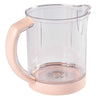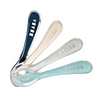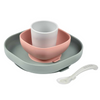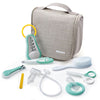THE 101 ON DEHYDRATING FOODS FOR LITTLE ONES
Dehydration is one of the most popular methods for extending the shelf life of food. If you’ve not heard of a dehydrator before, they resemble a large (or small!) microwave and use low temperatures to ‘fan dry’ foods such as fruits and vegetables and even meat and fish. They eliminate water and moisture from food, thereby extending its shelf life and resulting in delicious, healthy ‘dried’ snacks that are ideal for on-the-go (to eat as they are, or rehydrated).

What foods can be dehydrated and rehydrated?
Dehydrated foods can be a healthy and convenient option for snacks. They can also be added to salads, porridge/cereal, baked goods, and smoothies for a nutrient boost too. You can dehydrate almost any food such as fresh herbs and seasonings to prolong their shelf life such as basil, lavender, and mint, as well as fruits and vegetables such as apples, strawberries, bananas, apricots, carrots and mushrooms – even yoghurt and baby purees can be dehydrated!
There are some foods that are better not dehydrated though such as
avocados, olives, butter, milk, eggs and nuts.

Nutritional benefits
Dehydrated foods maintain nearly all of their nutritional value whilst producing an environment in which bacteria cannot flourish. Apple crisps/chips, for example, contain the same energy, protein, fat, carbohydrate, fibre, and natural sugar composition as the fresh fruit. The majority of a food’s minerals and vitamins are also preserved when dehydrated, especially in comparison to cooked/boiled food.

One of the benefits of dried or dehydrated foods such as fruits and vegetables, is that they are more concentrated in fibre, which although little ones don’t need a lot of on a daily basis* (in comparison to adults), some may struggle to get enough and may benefit from eating more fibre to support gut health – fibre helps to prevent and treat constipation for example.
*2 to 5 year-olds need around 15g of fibre a day and 5 to 11 year-olds need around 20g (NHS).
To ensure your little one is getting the variety of nutrients they need in order to grow and thrive, offer them a varied diet, with foods that are prepared in a variety of different ways i.e. dried, fresh and even frozen (and defrosted) i.e. include vegetables/ fruit as well as starchy carbohydrates (include of mix of white and whole-grain carbs), proteins (meat, fish and vegetarian alternatives such as beans and lentils) and dairy (or fortified alternatives) for calcium, as well as iodine.
Storage

Food must be stored in an airtight jar or container in a cold, dark area after dehydration (and 75% of the moisture has been removed); with dehydrated fruits and vegetables having a shelf life of a few months to a year.
Therefore, instead of throwing away fruits and vegetables that you wouldn’t eat before their use by or best before dates, you can dry them which will contribute to less food waste, a win for the environment and your budget too.
Dried foods can be expensive in-store, therefore dehydrating them at home allows you to save money on your food shop too.
What foods can be dehydrated for what age?
Over 6 months*
Dehydrated fruits and vegetables can work well with BLW (baby-led weaning), although aren’t suitable as a ‘first food’ when eating skills are being developed due to the texture and potential choking risk. Make sure pieces offered are soft and are of a similar shape and size to an adult’s finger so they can be easily gripped and chewed on/swallowed easily. Avoid pieces which could be a choking hazard (such as small round discs of dried banana). Little ones could for example munch on small chopped up pieces of dried apple slices for dessert, whilst practising their fine motor skills at the same time (including picking up and gripping). Dehydrated purees can also be great option for travel as they can be rehydrated when needed, mixed with drinks, or added to porridge or yoghurt.

*dehydrated but still soft pieces of fruits and vegetables may be more suitable once baby’s feeding skills are more mature, e.g. from 10 months plus, but harder dried fruits remain a choking risk until children are much older (around 4 years of age plus).
Experts suggest lots of soft, easy to mash in the gums foods initially from 6 months, with dehydrated and then rehydrated purees ideal too. When dehydrating purees containing meat or fish, ensure purees are cooked through first prior to dehydrating.
12 to 24 months plus
Snacks aren’t usually recommended until 12 months of age, as prior to this babies should be offered milk between their meals. Dehydrated foods (especially vegetables!) can be offered as a healthy snack for little ones while introducing them to new textures and flavours however fruits which contain a relatively higher amount of natural sugars should be offered with a meal (with water given afterwards) to protect dental health – dehydrated grapes for examples (raisins) can get stuck on little one’s teeth which can lead to dental caries.

Children aged 12 months and above (including adults too!) can have dried fruits and veggies as one of their 5-a-day portions, with one portion being around 30g for adults and 15g for children, which is approximately 1/2 to 1 tablespoon of raisins (not recommended in under twos for dental health) or mixed fruit or a small handful of dried banana chips.
By making them at home you can be sure there is no added sugar and even add your favourite flavourings such as cinnamon.
Dehydration Ideas
It’s super easy to use a dehydrator as you only need to wash and cut the foods and that’s it! Foods are typically dehydrated at 35°C-80°C or 115-130 degrees F for several hours. Encourage your children to ‘eat the rainbow’ in order to obtain a wide variety of vitamins, minerals and antioxidants.

Apple/Kiwi Rings* – Peel (optional), slice and dip in lemon juice to prevent browning. Dehydrate at 60°C for between 8 and12 hours. Dried rings taste delicious and make such a convenient snack to take on the go. You can even add cinnamon to the apple ring to give them extra flavour!
Strawberry Halves* – Slice off the tops, slice in half and dip in lemon juice to prevent browning. Dehydrate at 60°C for 6 to 10 hours. Strawberry halves taste super sweet and would be perfect as a snack or with porridge or yoghurt!
Banana Chips and Batons* – Peel, slice/chop and dip in lemon juice to prevent browning. Dehydrate at 60°C for 6 to 10 hours. Dried banana is chewy and tastes amazing.
Cucumber Chips* – Slice very thin (a mandolin slicer makes it easier!), dry and spritz with oil with a dash of salt and dehydrate at 60°C for 10 to 12 hours (skip the salt for children).
Potato Crisps/Chips* – Wash, peel and cut into thin slices. Steam 5 to 6 minutes. Rinse to remove starch after steaming. Dehydrate at 55°C for 8 to 10 hours. Use in soups, casseroles, and recipes using potatoes or add your favourite spices and serve as normal crisps or with a dip such as salsa or guacamole.

Dried Herbs/Tea – Herbs must be brittle and crumbly before storing, with all of their water content gone, or they will mould. Dehydrate them between 40°C and 70°C for 3 to 8 hours.
Herbs may be rehydrated quickly by soaking them in water for 10 minutes. When ready to use, they will require more cooking time than fresh to bring out their taste.
Carrot Crackers – If you have carrot or any other juice pulp leftover you can use it to make crackers! Simply, mix leftover juice pulp with spices and ground chia/flax seeds, make a dough and transfer onto the dehydrator sheets. Flatten the dough and cut it into cracker sizes. Dehydrate at 55°C for 12 hours, flip them over and continue dehydrating for another 12 hours. They taste great on their own or with hummus/salsa in a lunchbox!

Fruit Leather Roll-Ups* – Simply blend your chosen fruit(s) until it becomes a ‘pourable pulp’ consistency, then pour onto a drying sheet and spread out until 1/4 inch thick. Dehydrate for 10 hours at 60°C.
Carefully peel off the drying sheet and cut it into strips. Roll up with baking parchment and tie with string (optional!).
*Times may vary depending on the ripeness of your fruits, water content and amount per tray.
Experiment with other fruits such as mangos, nectarines, peaches, pears, kiwis and pineap-ples, as well as vegetables including courgette, tomatoes, mushrooms, broccoli and peppers (please refer to the manufacturers advice regarding time and temperature to dehydrate at). Meat and fish may also be dehydrated but avoid uncooked yet dried meat and fish for under ones or those with compromised immune systems. Caution should also be given regarding their texture/size/shape in relation to the consumer’s age and ability to chew foods well enough before swallowing. Dehydrated meats are also not recommended during pregnancy.
By Nichola Ludlam-Raine, Registered Dietitian – Visit @mummynutrition












































